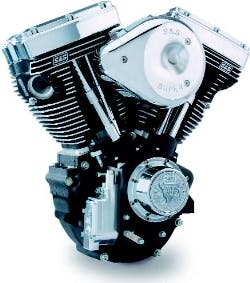Software supercharges engine design
S&S Cycle designed its 145-cubic-inch engine in less than six months.
S&S Cycle (www.sscycle.com), an aftermarket and OEM supplier in the American motorcycle industry, envisioned celebrating an upcoming 45th anniversary by creating its biggest production streetuse engine ever, a 145-cubic-inch model. However, the engine had to be ready within six months to debut at a 2003 Cycle World International Motorcycle Show in Dayton Beach, or S&S would miss its anniversary. Six months wasn't much time because the S&S team planned to leverage existing designs that would need numerous changes. Among these changes, the new engine required redesigned cylinders and heads, larger intake port, increased chamber size, updated valve geometry and new investment-cast tooling to create a larger fuel-injection system. S&S accomplished this design challenge and met its fast approaching anniversary deadline using OneSpace Designer Modeling, a 3D modeling tool from CoCreate (www.cocreate.com).
The software's dynamic-modeling capability let S&S make design changes quickly and develop new designs from old ones without the constraints of a history-based software. With OneSpace Designer, the 145-cubic-inch tribute engine's project designers brainstormed and experimented with new ideas and went from concept to release-ready in less than six months.
"If you don't like what you did, just hit the undo button," says Eric Wangen, concept designer for S&S. "You can go down one avenue, change your mind and go a different way. You can spend all your time thinking about the design and none trying to figure out how to constrain the model for making future changes possible."
The software also enhanced team productivity. Everyone could contribute because new designers were able to work on parts originally made by other engineers. And because the software is easy to learn, even designers new to it quickly became productive. In fact, one new designer was making parts for the engine within days of his introduction to OneSpace Designer, says Wangen.
He also says that without OneSpace Designer the engine project would have taken at least twice as long. Using other programs, the team would have had to create many more new designs during the testing process and start over each time changes were made. The process, using OneSpace, resulted in a high-quality product at a reasonable development cost. Just the savings of coming out with the right thing, tested in the design process itself, are huge, says Wangen.
